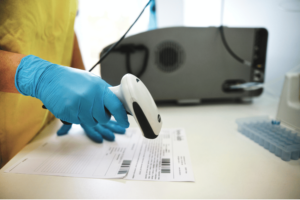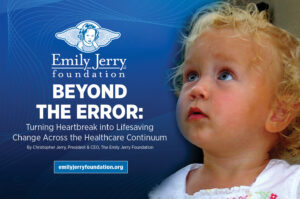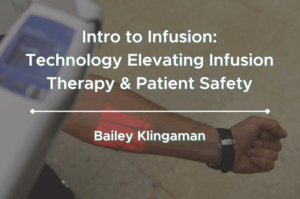Thank you to Rayburn Vrabel, former President and Principal Consultant at Vrabel Consulting Inc., and current Medication Systems Strategy Advisor, for allowing RxToolKit to publish his article, as originally seen on LinkedIn May 15, 2015, about the systems and practices that affect IV room safety.
Last week in Mark Neuenschwander’s Point of Care Forum (www.pointofcareforum.com), Mark has an interesting article entitled, “I’ve been thinking about minding the gap, looking right, and a potential blindspot in the medication-use process.” I think it could have also been called “Can’t see the forest for the trees.” I would encourage everyone to read this.
The bottom line is that, in our efforts to automate the medication use process, we have done the easy, less-risky tasks first, and virtually ignored, until recently, the most risky segment of the medication use process in hospitals: The Pharmacy IV Room. This is where pharmacy technicians prepare IV admixtures in a cleanroom environment.
Back in 2004, the United States Pharmacopeia (USP) implemented Chapter 797 (now referred to as USP797) which defined requirements for pharmacy IV rooms, bringing them up to cleanroom standards similar to those used by the pharmaceutical industry for sterile preparations.
Whether there was a serious problem with the cleanliness of the pharmacy IV rooms before, the USP797 standards now address that aspect of IV Room workflow (i.e., laminar airflow hoods, air handling, particulate counts, employee gloving and garbing, cleanroom layout, beyond-use-dating (BUD), etc.). We now have assurance of the sterility of products prepared in the Pharmacy IV Room.
One area that has not been addressed (i.e., The Gap, The Forest) are mechanisms to ensure that the correct components to an IV admixture (i.e., the label, the bag, and the vials of medication) are used for the preparation. For over 90 percent of hospitals, this is still done by manual inspection; initially by a pharmacy technician and later by a pharmacist after the IV admixture is prepared, often outside of the cleanroom.
 Does manual inspection always work? Apparently, not. At least it didn’t appear to in Bend, Oregon this past December when an IV admixture containing the anti-seizure medication, fosphenytoin, was accidentally prepared using a neuromuscular-blocking agent, rocuronium. The nurse scanned the barcode on the IV prepared for this patient, hung the IV on the patient, and then left the room. The patient went into cardiac arrest and later died after being taken off life support, secondary to lack of oxygen to the brain. The barcode scan by the nurse worked because the label on the IV bag indicated that it contained the correct drug, fosphenytoin, and it was for the correct patient. There was no way for the nurse to know that the clear IV solution contained the wrong drug.
Does manual inspection always work? Apparently, not. At least it didn’t appear to in Bend, Oregon this past December when an IV admixture containing the anti-seizure medication, fosphenytoin, was accidentally prepared using a neuromuscular-blocking agent, rocuronium. The nurse scanned the barcode on the IV prepared for this patient, hung the IV on the patient, and then left the room. The patient went into cardiac arrest and later died after being taken off life support, secondary to lack of oxygen to the brain. The barcode scan by the nurse worked because the label on the IV bag indicated that it contained the correct drug, fosphenytoin, and it was for the correct patient. There was no way for the nurse to know that the clear IV solution contained the wrong drug.
Guess what? Humans make errors when they are asked to perform repetitive tasks. That’s why grocery stores have been scanning barcodes on products since this technology was introduced on June 26th, 1974. Barcode scanning solved the “correct price” problem and provided additional inventory benefits.
It’s also why virtually EVERY hospital has implemented and/or will implement bedside barcode scanning (BCMA) in the next couple of years. Barcode scanning at the bedside ensures the Five Patient Rights: Right Patient, Right Drug, Right Dose, Right Route, and Right Time,
Unfortunately, in the Pharmacy IV Room, less than 10% of hospitals are using any type of technology to make sure that the right ingredients are used to prepare IV admixtures. Many of those that are using the available technology are only using it for high-risk drugs. Unfortunately, a fosphenytoin IV admixture is not a high-risk drug and therefore it would not have been prepared using this technology in most hospitals.
Barcode scanning technology for the IV Room is available from many of the major EHR vendors and more will have it available by the end of the year. Likewise, there are standalone technologies from other vendors available that can also be used.
Barcode scanning needs to be the minimum requirement for any hospital preparing IV admixtures and it needs to be done for ALL IV admixtures, not just for IV admixtures involving high-risk drugs. Barcode scanning in the Pharmacy IV Room can be difference of life or death as long as we have humans involved in the process.
We have a lot of mechanisms to rate the safety of hospitals (e.g., CMS Star Ratings, Leapfrog Hospital Safety Scores, HIMSS Analytics Stages), but you can excel at all of those and still be UNSAFE from a barcode scanning standpoint. There needs to be a Five Star Medication Barcode Scanning Score, one star for each of the areas benefiting by medication barcode scanning:
- All Inpatient Medication Dispensing,
- All Medication Stocking in Automated Dispensing Cabinets,
- All Outpatient Pharmacy Prescription Dispensing,
- All IV Admixture preparation, and
- All Bedside Medication Administration.
How many Medication Barcode Stars does your hospital have…???





